Axolotls, with their otherworldly appearance and calm demeanor, are a unique addition to any aquarium. However, ensuring they have the right tank mates is crucial for their well-being. Not all aquatic creatures make for good neighbors in the close confines of an aquarium, especially with the sensitive nature of axolotls.
In this visually-rich guide, we will introduce you to over ten ideal Axolotls tank mates, complete with vivid images, so you can create a harmonious and vibrant underwater world. Dive in to discover who makes the cut and who’s best kept at a fin’s distance
Get an overview of Axolotl
An axolotl is a type of freshwater salamander that likes to be alone. They do best in a tank with slow-moving water.
Even though they prefer their own company, axolotls are very calm animals. They spend most of their time at the bottom of the tank, taking it easy. They come out mostly at night when the tank lights are off because they’re night owls.
Here’s something important to know: axolotls eat meat, especially live prey. So, they might sneak up on resting fish and have a quick bite. However, because they move slowly, they usually don’t bother other small fish.
Axolotls prefer cooler water. This means the water isn’t suitable for many other types of freshwater animals due to the lower temperature they need. So, if you want to keep axolotls, remember to keep the water just right for them.
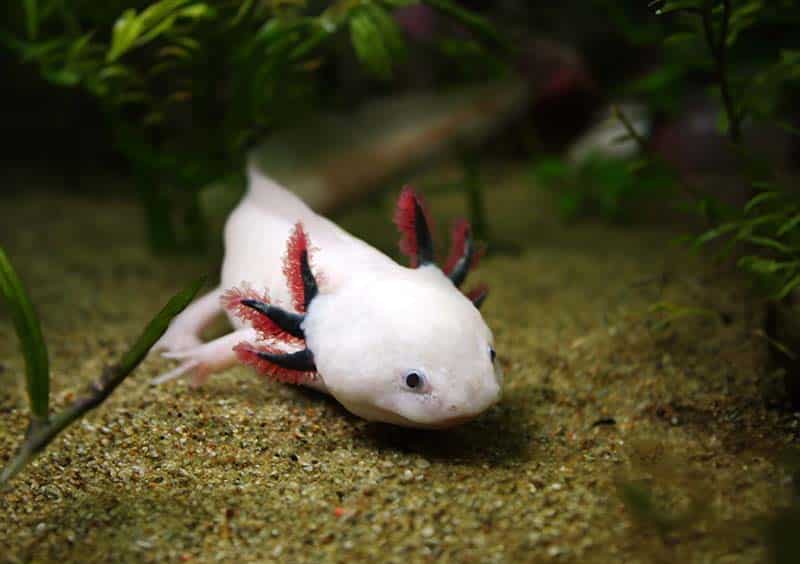
Factors to consider when choosing a tank mate
When selecting a tank mate for your Axolotl, several critical factors come into play. These considerations ensure a harmonious and healthy environment for all your underwater inhabitants.
Temperament
Most of the time, axolotls do best when they’re on their own. But if you want to give it a try, you can keep them with other water creatures.
However, it’s important to avoid any fish that are mean or like to boss others around. These types of animals can bother your axolotl and even harm it. Also, it’s not a good idea to put in fast-swimming fish because their quick movements can stress out your axolotl.
Size
While they can’t actually eat them, you might notice your axolotls playfully bothering their tank mates. That’s why it’s important to choose creatures that your axolotl can’t gulp down.
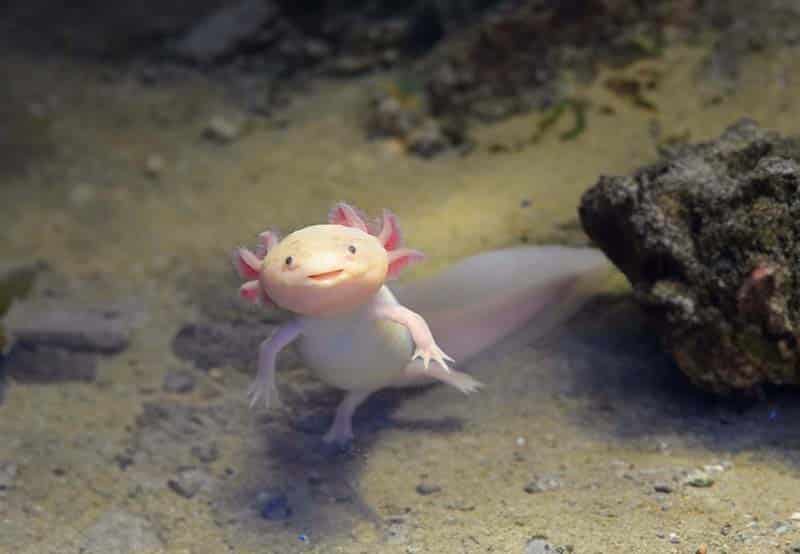
Competition
It’s not a good plan to add other bottom-dwelling fish either. These fish are in direct competition for food, meaning your axolotl might scare them away from their meals.
It’s also not a good match if the other animals are big eaters. Axolotls eat slowly, so they can’t keep up in a race for food with other bottom-dwelling fish.
Parameters ; Tank Setup
Adding other bottom-dwelling fish is not a wise choice. These fish compete for food, and your axolotl could intimidate them, preventing them from eating.
This is especially problematic if the other creatures are hearty eaters. Axolotls eat at a leisurely pace, so they can’t keep up in a food race with other bottom-dwelling fish.
10+ Best Axolotl Tank Mates
These best Axolotl tank mates can enhance your tank’s diversity and create a captivating underwater world.
Guppy fish
- Scientific Name: Poecilia reticulata
- Adult Size: 1 – 2 inches
- Compatible with: Cardinal Tetras
- Water Temperature: 72 to 82°F/22-28°C
- Minimum tank size: 5 gallons
- Care Level: Beginner
- Origin: South America
Another fish option that usually doesn’t pose a threat to your axolotls is the guppy. Guppies are more likely to be eaten compared to the fast-swimming white cloud minnows, although they can occasionally carry diseases.
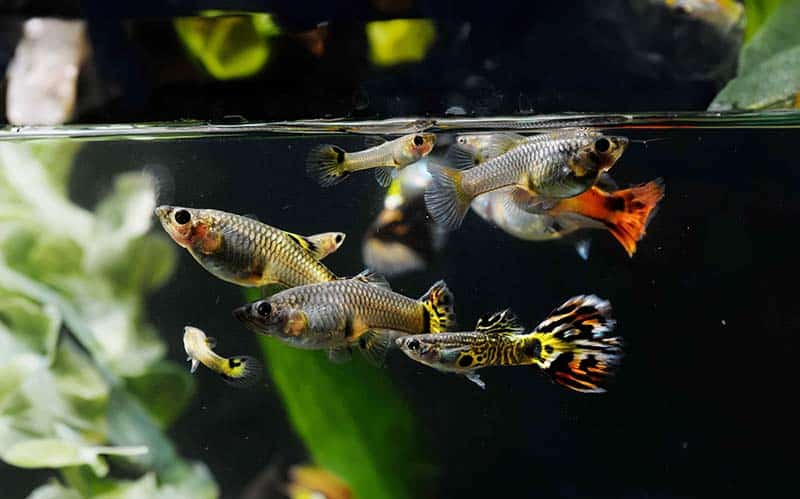
Guppy offspring are often used as food, meaning some axolotl owners intentionally offer these tiny fish as snacks. However, when young axolotls consume baby guppies, it usually doesn’t harm their health due to the small size of the prey.
One thing to keep in mind is that guppies reproduce rapidly because they give birth to live young. Despite being a simple meal, the quick increase in the fish population can stress your axolotl.
| Pros | Cons |
| – Usually safe for axolotls to eat. | – A large number of guppies might stress your axolotl. |
| – Guppies breed quickly. | – Guppies may nip at the feathery gills of an axolotl. |
| – Smaller juvenile axolotls could have trouble swallowing guppies and might choke on them. |
Mosquito Fish
- Scientific Name: Gambusia affinis
- Adult Size: 2.5 inches
- Compatible with: Koi
- Water Temperature: 33 to 104°F/0 to 40°C
- Minimum tank size: 20 gallons
- Care Level: Beginner
- Origin: South-Eastern USA
Mosquito fish come with some variation, mainly because females are significantly larger than males, and they can handle a wide range of temperatures. This makes them less likely to be hunted by axolotls and more robust compared to some other fish on this list.
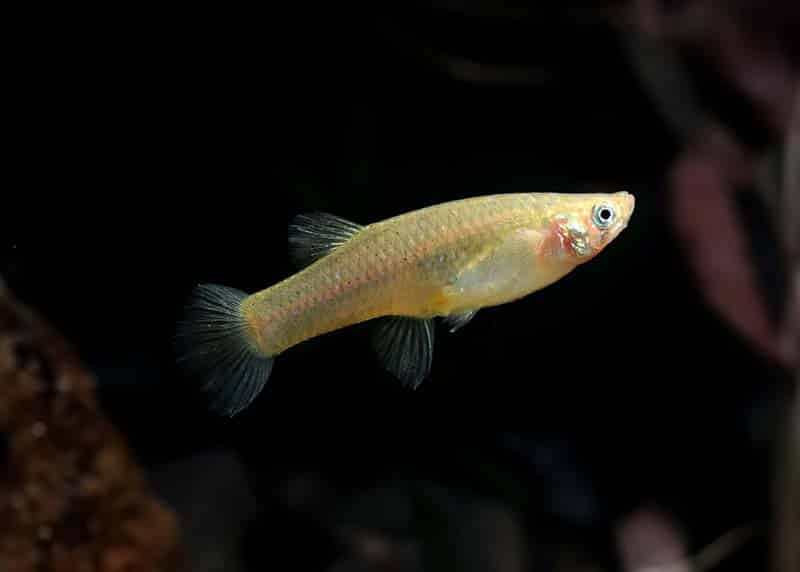
| Pros | Cons |
| – Mosquito fish prefer cooler water, suitable for axolotls. | – Requires a larger tank size due to their size. |
| – Mosquito fish are relatively large and less likely to be eaten. |
Cardinal Tetra
- Scientific Name: Paracheriodon Axelrod
- Adult Size: 1.25 inches
- Compatible with: Black Skirt Tetra
- Water Temperature: 73 to 81°F/23 to 27°C
- Minimum tank size: 20 gallons
- Care Level: Intermediate
- Origin: South America
Cardinal tetras can be a splendid choice to add a burst of color to your axolotl aquarium! These petite fish are gentle and won’t bother your axolotl in any way.
Since they enjoy being in groups, it’s best to have at least six of these blue and red beauties together. If your axolotl attempts to make a move, cardinal tetras can protect themselves by sticking together.
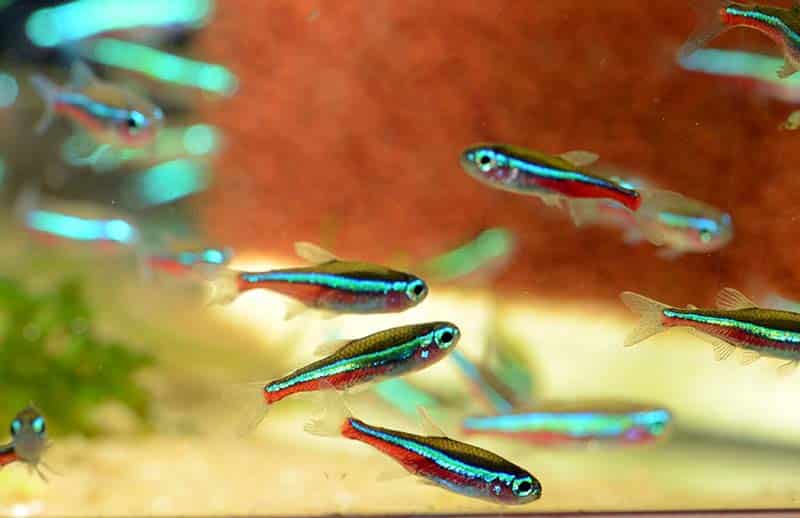
Here’s more good news: cardinal tetras aren’t prolific breeders, so you likely won’t have to deal with lots of eggs or young fish in your tank unless you’re particularly lucky.
| Pros | Cons |
| – Vibrant colors add visual appeal. | – Requires a larger tank. |
| – Peaceful and won’t disturb your axolotls. | – Takes a bit more effort to care for them. |
| – They don’t reproduce excessively. |
Zebra Danios
- Scientific Name: Paracheriodon Axelrod
- Adult Size: 1.25 inches
- Compatible with: Black Skirt Tetra
- Water Temperature: 73 to 81°F/23 to 27°C
- Minimum tank size: 20 gallons
- Care Level: Intermediate
- Origin: South America
If you’re looking to add a burst of color to your axolotl aquarium, consider the cardinal tetra! These small fish are gentle and won’t bother your axolotl in any way.
Cardinal tetras prefer to be in groups, so it’s a good idea to have at least six of these blue and red gems together. Should your axolotl attempt any antics, the cardinal tetras can stick together and protect themselves.
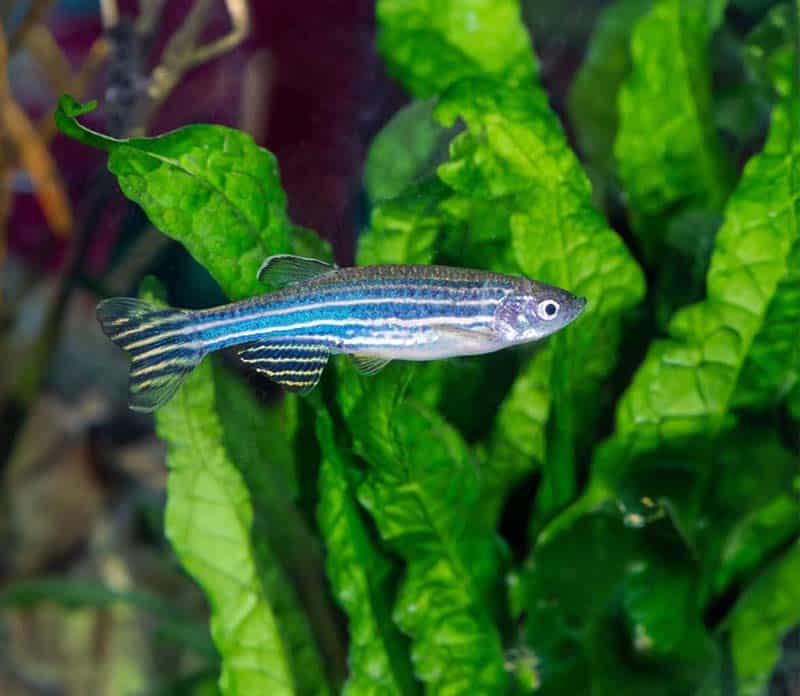
Here’s more good news: cardinal tetras don’t reproduce excessively, so you probably won’t have to deal with a lot of eggs or baby fish unless you’re particularly fortunate.
| Pros | Cons |
| – Their vivid hues contribute to the aesthetic charm of your aquarium. | – You’ll need a larger tank. |
| – They’re peaceful and won’t disrupt your axolotls. | – Caring for them may require more effort. |
| – They don’t reproduce in large numbers. |
Apple Snails
- Scientific Name: Ampullariidae
- Adult Size: 2 – 3 inches
- Compatible with: Danios
- Water Temperature: 64 to 82°F/18 to 28°C
- Minimum tank size: 10 gallons
- Care Level: Beginner
- Origin: South America
Having adult apple snails alongside juvenile axolotls in the same tank is generally safe. They are too large for your curious axolotls to gobble up, and while they are soft enough to be partially digested, they are not delicate enough to be swallowed.
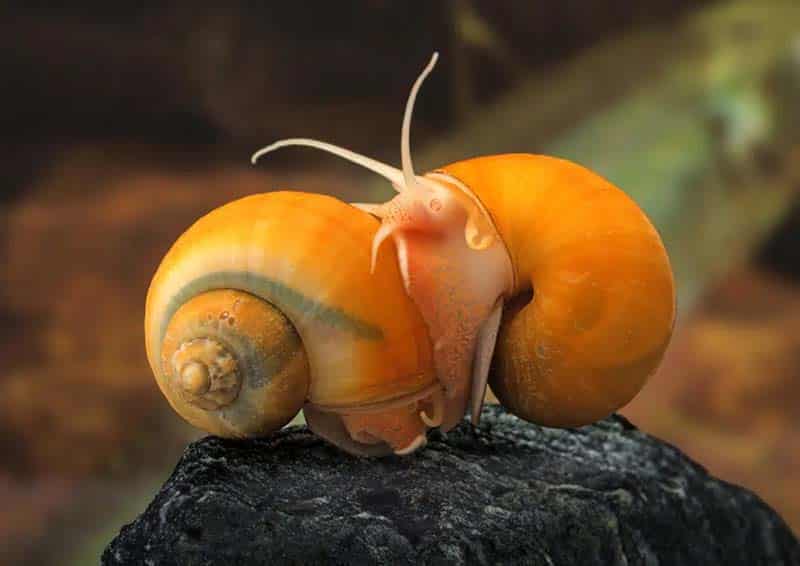
However, it’s a good idea to avoid very tiny snails and keep only adult apple snails if you want snails in your tank. Having multiple snails can be risky because they might climb onto your axolotl and nibble on its slime.
| Pros | Cons |
| – Apple snails are too big for axolotls to eat. | – Occasionally, axolotls may be at risk from the shells or exoskeletons of snails. |
| – If apple snails reproduce excessively, they can be challenging to remove from your aquarium. | |
| – There’s a possibility that they might carry infections from the outdoors. |
Small Shrimp
- Scientific Name: Palaemonetes paludosus
- Adult Size: 1.5 inches
- Compatible with: Small Invertebrates
- Water Temperature: 65 to 84°F/29°C
- Minimum tank size: 5 gallons
- Care Level: Intermediate
- Origin: North America
In any freshwater aquarium that houses Amano shrimp or ghost/glass shrimp, you’ll see some real benefits. These little bottom feeders are excellent at tidying up leftover food by foraging through the substrate. As a result, your axolotl aquarium will stay clean.
Shrimp can be great hiders, especially with their nearly see-through bodies, especially if your tank has plants. But if your axolotls want to find them, they can, thanks to their sharp sense of smell.
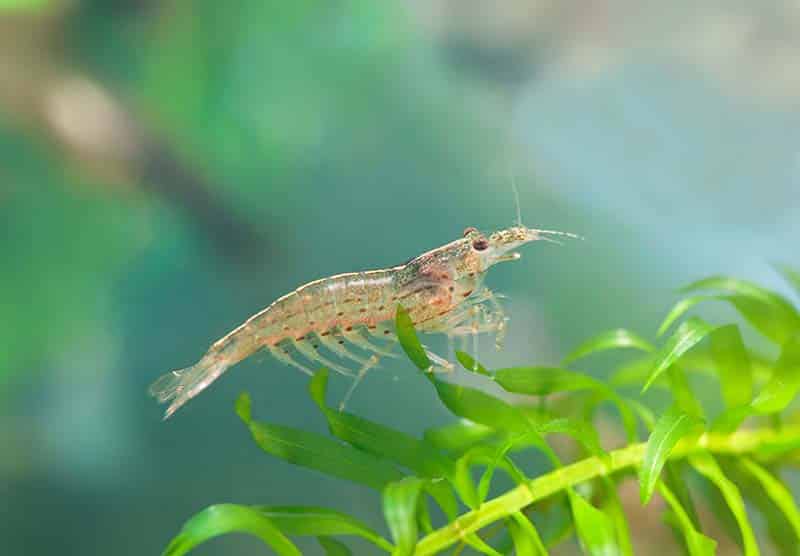
Interestingly, Amano shrimp are small enough to be eaten without causing any digestive problems for your axolotls. Some owners even offer shrimp as an occasional treat.
| Pros | Cons |
| – Help clean up leftover food in the tank. | – Axolotls might see them as prey and hunt them. |
| – Safe for axolotls to eat. |
Rosy Barbs
- Scientific Name: Pethia conchonius
- Adult Size: 6 inches
- Compatible with: Swordtails
- Water Temperature: 64 to 72°F/18 to 22°C
- Minimum tank size: 20 gallons
- Care Level: Intermediate
- Origin: India
Axolotls can usually get along well with rosy barbs, which are among the larger fish on this list. They are one of the few tankmates here that are unlikely to become a snack due to their size!
Rosy barbs resemble giant goldfish in appearance but are much more reserved. Because they are gentle by nature, they are unlikely to bother your axolotl.
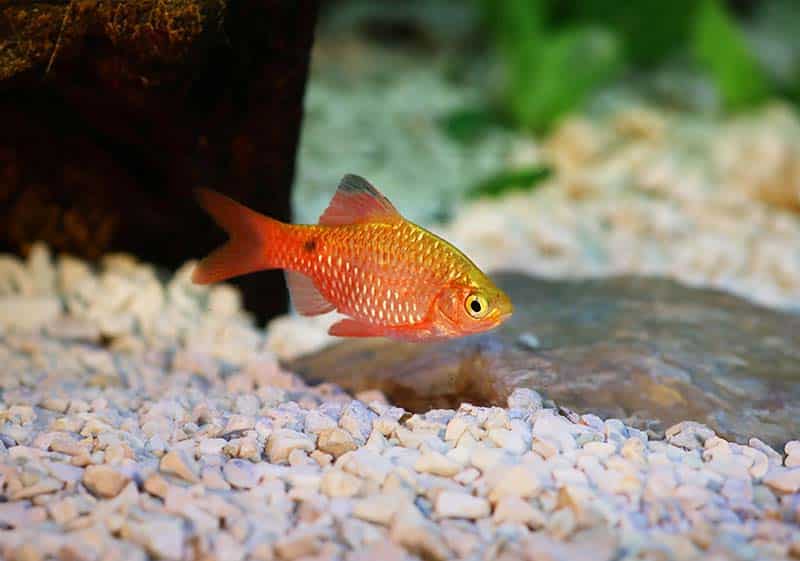
However, it’s important to note that accommodating a fish of this size alongside an axolotl requires a massive tank. You should have at least five rosy barbs together because they prefer to be in schools. This necessitates a substantial tank, typically around 50 gallons, to provide everyone with ample space, especially considering that axolotls benefit from shallower water.
| Pros | Cons |
| – Larger size makes them less likely to be hunted by axolotls. | – You’ll need to keep multiple rosy barbs together. |
| – Rosy barbs have a reserved temperament. | – A larger tank is required to accommodate both the axolotl and the rosy barbs. |
White Cloud Mountain Minnows
- Scientific Name: Tanichthys albonubes
- Adult Size: 1.5 inches
- Compatible with: Bloodfin Tetra
- Water Temperature: 64–72°F/18–22°C
- Minimum tank size: 10 to 12 gallons
- Care Level: Beginner
- Origin: China
Axolotls can peacefully coexist with serene white cloud minnows because they both prefer cool-water environments. These minnows lack spines and shells, making them safe for axolotls to consume, even if that’s not your intention.
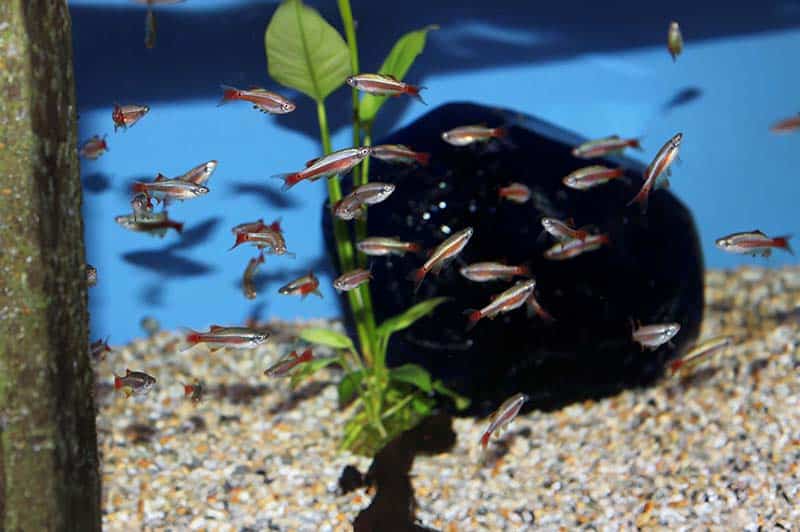
However, it’s important to know that your axolotls will likely hunt these fish, so you may want to consider keeping them in separate tanks. Fortunately, white cloud minnows are incredibly agile. If they aren’t caught off guard, they should be able to evade the axolotls.
| Pros | Cons |
| – They share the same water temperature preferences. | – Axolotls will likely hunt them. |
| – Safe for axolotls to eat if desired. |
Dojo Loaches
- Scientific Name: Misgurnus anguillicaudatus
- Adult Size: 6 to 8 inches
- Compatible with: White Cloud Minnows
- Water Temperature: 59 to 77°F/15 to 25°C
- Minimum tank size: 55 gallons
- Care Level: Beginner
- Origin: East Asia
Dojo loaches are often overlooked as potential tankmates for axolotls. They have a body shape resembling that of an eel and prefer cold water.
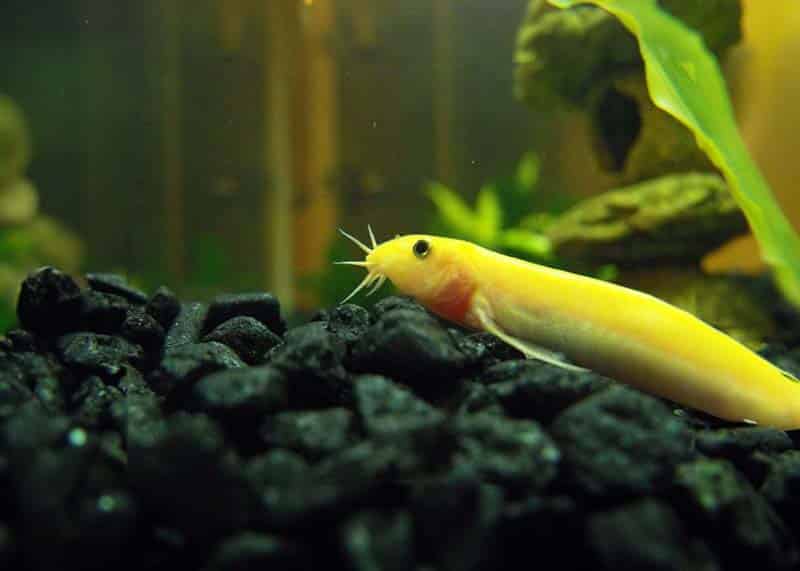
Dojo loaches share many dietary preferences with axolotls, including pellets, brine shrimp, and frozen bloodworms.
| Pros | Cons |
| – Prefers cold water, which aligns with axolotls. | – Requires a much larger tank due to their adult size. |
| – Similar dietary requirements. |
Pearl Danios
- Scientific Name: Danio albolineatus
- Adult Size: 2.5 inches
- Compatible with: Guppies
- Water Temperature: 72 to 76°F/22 to 24°C
- Minimum tank size: 10 gallons
- Care Level: Beginner
- Origin: Thailand
Pearl danios can be excellent tankmates for axolotls, much like their zebra danio cousins. These small fish shimmer in soft hues as they glide through your aquarium.
To feel secure, pearl danios should be kept in groups of at least six, as they are schooling fish. Additionally, if needed, they can quickly dart away from your axolotl.
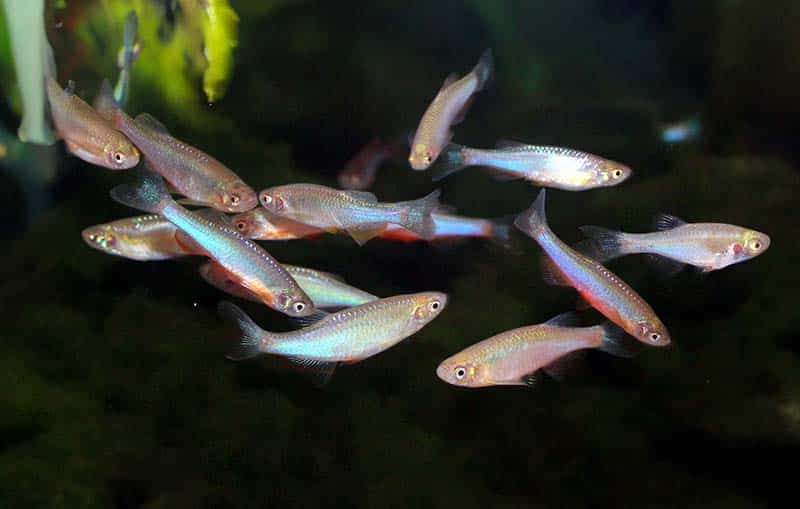
Because pearl danios are calm and peaceful, your axolotl shouldn’t have any issues with them.
| Pros | Cons |
| – They form schools, offering protection against axolotls. | – You need to keep multiple danios in the tank for their well-being. |
| – Fast swimmers. |
Other Axolotls
Adult axolotls can be wonderful tank companions. While it’s preferable to keep a male and a female together if you don’t want any offspring, you can also house same-gender axolotls in the same tank.
However, it’s best to separate young axolotls from adults, and young axolotls should not be kept together either. They often display cannibalistic behavior towards one another, and given the opportunity, adults may even consume their larvae.
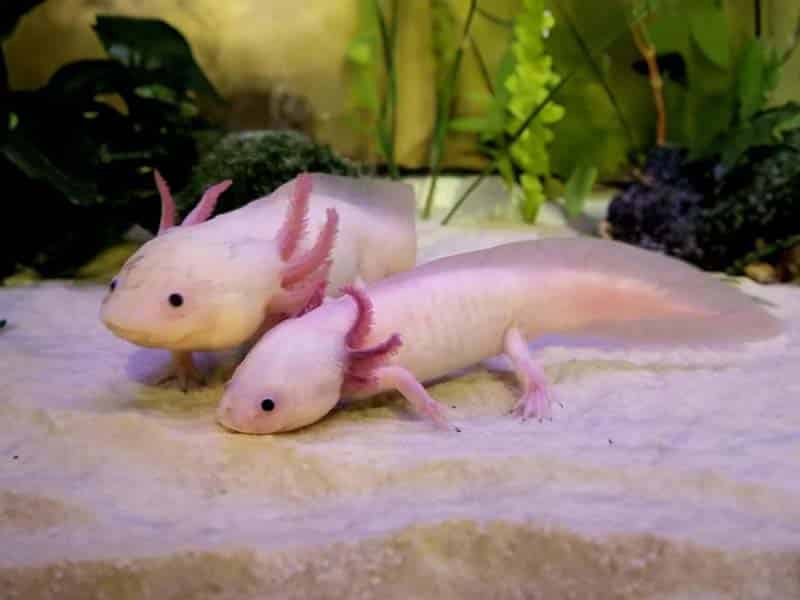
If you notice recurring issues, it’s advisable to segregate axolotls into different aquariums. Ideally, it’s best to have only one axolotl in a tank.
| Pros | Cons |
| – They have similar temperaments. | – Keeping male and female axolotls together can result in offspring. |
| – Share the same living conditions and diet. | – Young axolotls can be highly competitive with each other. |
Conclusion
In conclusion, choosing the right axolotl tank mates is crucial for their well-being. Whether you opt for peaceful fish like cardinal tetras or bottom-dwellers like apple snails, a harmonious aquatic community is within reach.
For more insightful articles on aquaristics and marine life, explore our other blogs at National Park Aquarium. Dive in and discover the wonders of underwater companionship today.
Refer to other articles:
13 Best Betta Tank Mates & Companions (4 To Avoid)




